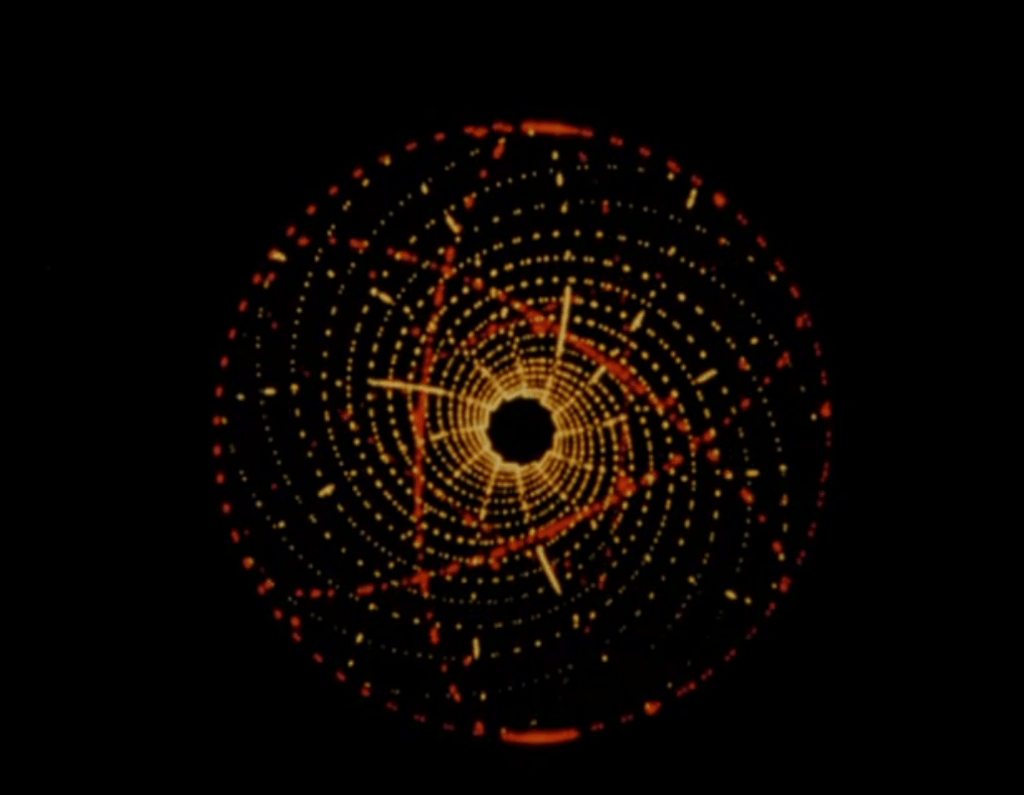- One of the films that guides us into outer space and into the mental space we claim for ourselves in this year’s programme of the same name is Jordan Belson’s Allures. Below, we present the text that Gene Youngblood dedicates to it in his legendary book Expanded Cinema.

Originally a widely-exhibited painter, Belson turned to filmmaking in 1947 with crude animations drawn on cards, which he subsequently destroyed. He returned to painting for four years and in 1952 resumed film work with a series that blended cinema and painting through the use of animated scrolls. The four films produced in the period 1952-53 were Mambo, Caravan, Mandala, and Bop Scotch. From 1957-59 he worked with Henry Jacobs as visual director of the Vortex Concerts at Morrison Planetarium in San Francisco. Simultaneously he produced three more animated films, Flight (1958), Raga (1959), and Seance (1959). Allures, completed in 1961, found Belson moving away from single-frame animation toward continuous real-time photography. It is the earliest of his works that he still considers relevant enough to discuss.
He describes Allures as a “mathematically precise” film on the theme of cosmogenesis— Teilhard de Chardin’s term intended to replace cosmology and to indicate that the universe is not a static phenomenon but a process of becoming, of attaining new levels of existence and organization. However, Belson adds: “It relates more to human physical perceptions than my other films. It’s a trip backwards along the senses into the interior of the being. It fixes your gaze, physically holds your attention.”
Allures begins with an ethereal pealing of bells. A centrifugal starburst of pink, yellow, and blue sparks whirls out of a black void. Its points collect into clusters and fade. Bells become weird chimes; we sink into a bottomless orange and black vortex. An intricate pink mandala of interconnected web patterns spins swiftly into the distance. A caterpillar-like coil looms ominously out of infinity. We hear a tweetering electronic warble, a collection of threatening piano notes. Pink and yellow sparks wiggle vertically up the frame. Distant snakelike coils appear and fade. A tiny sun surrounded by a huge orange halo disintegrates. There are flying, comet-like petal shapes.
Oscilloscope streak-dots bounce across the frame with a twittering, chattering metallic noise. They form complex triangular and tetrahedral grid patterns of red, yellow, and blue. Out of this evolves an amorphous yellow-white pulsating globe of fire without definite shape. It vanishes and a blue, neon-bright baton rotates slowly into infinity.
“I think of Allures,” said Belson, “as a combination of molecular structures and astronomical events mixed with subconscious and subjective phenomena— all happening simultaneously. The beginning is almost purely sensual, the end perhaps totally nonmaterial. It seems to move from matter to spirit in some way. Allures was the first film to really open up spatially. Oskar Fischinger had been experimenting with spatial dimensions but Allures seemed to be outer space rather than earth space. Of course you see the finished film, carefully calculated to give you a specific impression. In fact it took a year and a half to make, pieced together in thousands of different ways, and the final product is only five minutes long. Allures actually developed out of images I was working with in the Vortex Concerts. Up until that time my films had been pretty much rapid-fire. They were animated and there was no real pacing— just one sustained frenetic pace. After working with some very sophisticated equipment at Vortex I learned the effectiveness of something as simple as fading in and out very slowly. But it was all still very impersonal. There’s nothing really personal in the images of Allures.”
After the glowing blue baton vanishes the screen is black and silent. Almost imperceptibly a cluster of blue dots breaks from the bottom into magnetic force fields that become a complex grid pattern of geometrical shapes superposed on one another until the frame is filled with dynamic energy and mathematical motion. A screeching electronic howl accentuates the tension as galaxies of force fields collide, permutate, and transmute spectacularly. Some squadrons rush toward the camera as others speed away. Some move diagonally, others horizontally or vertically. It’s all strongly reminiscent of 2001— except that it was made seven years earlier. Elsewhere in the film rumbling thunder is heard as flying sparks collect into revolving atomic structures, from whose nuclei emanate shimmering tentacles of tweetering multicolored light. At the end we hear ethereal harp music as a pulsating sun, fitfully spewing out bright particles, reveals within itself another glimmering galaxy.





